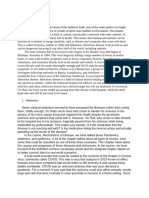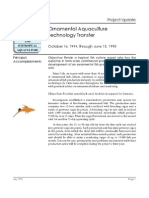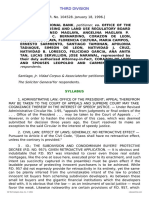Rabid: A Cultural History of The World's Most Diabolical Virus Is A Popular Science
Rabid: A Cultural History of The World's Most Diabolical Virus Is A Popular Science
Uploaded by
Rama MurthyCopyright:
Available Formats
Rabid: A Cultural History of The World's Most Diabolical Virus Is A Popular Science
Rabid: A Cultural History of The World's Most Diabolical Virus Is A Popular Science
Uploaded by
Rama MurthyOriginal Description:
Original Title
Copyright
Available Formats
Share this document
Did you find this document useful?
Is this content inappropriate?
Copyright:
Available Formats
Rabid: A Cultural History of The World's Most Diabolical Virus Is A Popular Science
Rabid: A Cultural History of The World's Most Diabolical Virus Is A Popular Science
Uploaded by
Rama MurthyCopyright:
Available Formats
Rabid: A Cultural History of the worlds most diabolical virus is a popular science book, published in July.
It was written by Bill Wasik, a journalist interested in technology and crowd dynamics (think of ideas going viral), and his wife Monica Murphy a veterinarian with a degree in public health. This combination of interests has produced a book that explores not only the conventional science and history of rabies, but also its impact on cultures worldwide, from the earliest recordings 4,000 years ago, through our understanding its transmission and prevention, right to its influence on modern zombie films. At first the focus on the horrific aspects of rabies and the reliance on media references put me off as sensationalist. I worried that the reality of rabies and its impacts on many countries where rabies is endemic would be left out to focus on how the horror of rabies has been used to sell books and movies. But the book is more balanced with detailed research and there are excellent chapters on Pasteurs work to develop the vaccine, the science and controversy of work to help patients survive clinical rabies and the recent outbreak of canine rabies on Bali, which leave you with realistic impression of the historical and modern quandaries of working in rabies control. Throughout, the personalities of victims, researchers, novelists and philanthropists touched by rabies are used to chart a very human history. In the later chapters as the names and situations became familiar to me, I found it even more compelling. The book neatly and readably charts the progress of mankinds understanding of rabies, its causes and its cures from ancient texts to possible future uses of the rabies virus to treat other diseases. Along the way I learnt that the 4,000 year old Laws of Eshnunna set out fines for owners of rabid dogs that infected and killed people. An Ayurvedic text, written by Su?ruta at least 2,000 years ago included a highly accurate description of the disease and first identified hydrophobia as a characteristic and fatal symptom. Many early cures for rabid animal bites are detailed, from applying burnt herbs to the wound, to sweating out the evil, to applying poultry dung and vinegar, and any number of ways to use parts of the offending rabid dog to prevent the onset of rabies. The book makes interesting observations, such as the dual role of dogs in human society (as beloved pets and as problematic strays) and how concepts of the disease itself and general rage (meaning animalistic fury) have been intertwined in many cultures. It shows how the fear that rabies exerts on us has influenced fictional writing from Charlotte Bronte to Edgar Alan Poe (who may even have died to rabies himself) to modern zombie films. The authors suggest that clinical symptoms of rabies have influenced the fictional characteristics of werewolves, vampires, monsters and zombies, playing on our innate fear of man transforming into animal. I was surprised to find that a 1998 paper in Neurology was devoted to this subject. This is a cultural history which makes a priority of mentioning how the fear of rabies can affect communities an aspect often left out of more clinical medical accounts. Very little popular science writing focuses on rabies. If we are interested in increasing awareness about rabies, we need as many tools as we can get. To me the reality of rabies is fascinating and frightening enough but if this book pulls in readers attracted by the
pulp fiction horror aspects of the book, and leaves them with an understanding of the reality, then that is fine by me. This review is a personal opinion of Louise Taylor of GARC, who despite living in Pittsburgh, the cultural home of zombie movies, is still not a fan of the undead.
You might also like
- ROADMAP B1 + Unit - Test - 10 - PDFDocument2 pagesROADMAP B1 + Unit - Test - 10 - PDFLakmus650% (2)
- Parasites: Tales of Humanity's Most Unwelcome GuestsFrom EverandParasites: Tales of Humanity's Most Unwelcome GuestsRating: 3.5 out of 5 stars3.5/5 (6)
- Solution Manual Thermodynamics Sanford KleinDocument65 pagesSolution Manual Thermodynamics Sanford KleinMonica estefania Leal bossaNo ratings yet
- Catching Breath: The Making and Unmaking of TuberculosisFrom EverandCatching Breath: The Making and Unmaking of TuberculosisRating: 4 out of 5 stars4/5 (10)
- Thinking Like a Phage: The Genius of the Viruses That Infect Bacteria and ArchaeaFrom EverandThinking Like a Phage: The Genius of the Viruses That Infect Bacteria and ArchaeaNo ratings yet
- Annotated Bibliography For Assignment 2Document5 pagesAnnotated Bibliography For Assignment 2Jasmine Delaine100% (1)
- The Kiss of Death: Contagion, Contamination, and FolkloreFrom EverandThe Kiss of Death: Contagion, Contamination, and FolkloreRating: 4.5 out of 5 stars4.5/5 (2)
- Boomtown Build Challenge A4Document1 pageBoomtown Build Challenge A4api-249586841No ratings yet
- Homework Response 6Document2 pagesHomework Response 6kmudd1No ratings yet
- Battling Demons With Medical AuthorityDocument18 pagesBattling Demons With Medical Authoritynbkjbjkbjkbjk100% (1)
- RabiesDocument190 pagesRabiesIr Ardy YusriawanNo ratings yet
- Annotated BibliographyDocument3 pagesAnnotated Bibliographykmudd1No ratings yet
- Interview With Professor Ronald Hutton, For New DawnDocument7 pagesInterview With Professor Ronald Hutton, For New DawnMatthew Levi StevensNo ratings yet
- The Vampire Myth and ChristianityDocument69 pagesThe Vampire Myth and ChristianitysamNo ratings yet
- Get Logic and Philosophy Today 1st Edition Amitabha Gupta PDF ebook with Full Chapters NowDocument85 pagesGet Logic and Philosophy Today 1st Edition Amitabha Gupta PDF ebook with Full Chapters Nowhalismandil41100% (4)
- INHERIT THE EARTH or Dont LolDocument2 pagesINHERIT THE EARTH or Dont Lollahabo5525No ratings yet
- Download full Humans Animals and Biopolitics The more than human condition Kristin Asdal ebook all chaptersDocument59 pagesDownload full Humans Animals and Biopolitics The more than human condition Kristin Asdal ebook all chaptersbonerkynanzo100% (5)
- Fungi As Human PathogensDocument20 pagesFungi As Human PathogensArdista RaniNo ratings yet
- Introduction: Monsters, Anthropology, and Monster Studies: Yasmine MusharbashDocument2 pagesIntroduction: Monsters, Anthropology, and Monster Studies: Yasmine MusharbashVada DemidovNo ratings yet
- Animal Viruses and Humans, A Narrow Divide: How Lethal Zoonotic Viruses Spill Over and Threaten Us. ISBN 1589881222, 978-1589881228Document23 pagesAnimal Viruses and Humans, A Narrow Divide: How Lethal Zoonotic Viruses Spill Over and Threaten Us. ISBN 1589881222, 978-1589881228rosenebutterfieldxl720100% (16)
- Bubonic Plague Term PaperDocument7 pagesBubonic Plague Term Paperafdtywgdu100% (1)
- 2022 Fall Chem 183 001 20220901 - 115733 - Zoom - 21096.CCDocument11 pages2022 Fall Chem 183 001 20220901 - 115733 - Zoom - 21096.CCjennifer hollandNo ratings yet
- 2018 Bookmatter MicrobesAndOtherShamanicBeingsDocument18 pages2018 Bookmatter MicrobesAndOtherShamanicBeingsTiago PereiraNo ratings yet
- Animal Viruses and HumansDocument201 pagesAnimal Viruses and HumansPetrisor GheorghiuNo ratings yet
- People, Parasites, and Plowshares: Learning From Our Body's Most Terrifying InvadersFrom EverandPeople, Parasites, and Plowshares: Learning From Our Body's Most Terrifying InvadersRating: 4.5 out of 5 stars4.5/5 (2)
- Pests and Pestilence: The Management of Invasive Species, Pests and Disease in New ZealandFrom EverandPests and Pestilence: The Management of Invasive Species, Pests and Disease in New ZealandNo ratings yet
- The European Vampire Applied Psychoanalysis and Applied LegendDocument23 pagesThe European Vampire Applied Psychoanalysis and Applied LegendFerencz Iozsef100% (1)
- Girard, The Plauge in Literature and MythDocument19 pagesGirard, The Plauge in Literature and Mythmanuel.grisaceoNo ratings yet
- PAN JournalDocument197 pagesPAN JournalJohn KannenbergNo ratings yet
- History and Story DRAFT ExtraDocument8 pagesHistory and Story DRAFT ExtralouiseNo ratings yet
- The Politically Incorrect Guide to PandemicsFrom EverandThe Politically Incorrect Guide to PandemicsRating: 5 out of 5 stars5/5 (2)
- The Encyclopedia of Psychoactive SubstancesFrom EverandThe Encyclopedia of Psychoactive SubstancesRating: 4 out of 5 stars4/5 (3)
- Infectious: A Doctor's Eye-Opening Insights into Contagious DiseasesFrom EverandInfectious: A Doctor's Eye-Opening Insights into Contagious DiseasesRating: 4 out of 5 stars4/5 (2)
- Culture and MediaDocument12 pagesCulture and MediaJesuspistoNo ratings yet
- Every Living Thing: Man's Obsessive Quest to Catalog Life, from Nanobacteria to New MonkeysFrom EverandEvery Living Thing: Man's Obsessive Quest to Catalog Life, from Nanobacteria to New MonkeysRating: 4 out of 5 stars4/5 (23)
- Download Complete Microbes and Other Shamanic Beings 1st Edition César E. Giraldo Herrera PDF for All ChaptersDocument41 pagesDownload Complete Microbes and Other Shamanic Beings 1st Edition César E. Giraldo Herrera PDF for All Chaptersmilaskonekdb100% (1)
- Viruses: A Scientific American Library BookFrom EverandViruses: A Scientific American Library BookRating: 4.5 out of 5 stars4.5/5 (12)
- The Lure of HorrorDocument4 pagesThe Lure of HorrorGriffin ThayerNo ratings yet
- Apparitions at the Moment of Death: The Living Ghost in Legend, Lyric, and LoreFrom EverandApparitions at the Moment of Death: The Living Ghost in Legend, Lyric, and LoreNo ratings yet
- Thriving with Microbes: The Unseen Intelligence Within and Around UsFrom EverandThriving with Microbes: The Unseen Intelligence Within and Around UsNo ratings yet
- The Goodness Paradox: The Strange Relationship Between Virtue and Violence in Human EvolutionFrom EverandThe Goodness Paradox: The Strange Relationship Between Virtue and Violence in Human EvolutionRating: 4 out of 5 stars4/5 (28)
- Times and Tides of Tuberculosis: Perceptions Revealed in Literature, Keats to SontagFrom EverandTimes and Tides of Tuberculosis: Perceptions Revealed in Literature, Keats to SontagNo ratings yet
- Science and Society Book Discussion. The Invisible Enemy: A Natural History of Viruses. Professor Dorothy Crawford FRSE OBEDocument4 pagesScience and Society Book Discussion. The Invisible Enemy: A Natural History of Viruses. Professor Dorothy Crawford FRSE OBEThe Royal Society of EdinburghNo ratings yet
- Anthrax PDFDocument112 pagesAnthrax PDFSyed Abdullah Mohsin Raza100% (2)
- Spillover Assignment 1Document2 pagesSpillover Assignment 1makenzie.t.harrisNo ratings yet
- Plagues and Peoples Thesis StatementDocument5 pagesPlagues and Peoples Thesis Statementbsq1j65w100% (2)
- Girard - The Plague in Literature and MythDocument19 pagesGirard - The Plague in Literature and MythlucasNo ratings yet
- (Crime Files) Sylvia A. Pamboukian - Agatha Christie and The Guilty Pleasure of Poison-Palgrave Macmillan (2022)Document230 pages(Crime Files) Sylvia A. Pamboukian - Agatha Christie and The Guilty Pleasure of Poison-Palgrave Macmillan (2022)ОленаКоляса100% (1)
- 36IJELS 109202041 Pandemic PDFDocument4 pages36IJELS 109202041 Pandemic PDFIJELS Research JournalNo ratings yet
- Chimpanzee Culture Wars: Rethinking Human Nature alongside Japanese, European, and American Cultural PrimatologistsFrom EverandChimpanzee Culture Wars: Rethinking Human Nature alongside Japanese, European, and American Cultural PrimatologistsNo ratings yet
- Blume, Stuart - Immunization. How Vaccines Became ControversialDocument272 pagesBlume, Stuart - Immunization. How Vaccines Became ControversialFredrik Edmund FirthNo ratings yet
- Senior High School Student Permanent Record: Republic of The Philippines Department of EducationDocument3 pagesSenior High School Student Permanent Record: Republic of The Philippines Department of EducationJennisRollenAranetaMaagadNo ratings yet
- 2024 Calendar Planner Philippines Excel 01Document24 pages2024 Calendar Planner Philippines Excel 01Na YumiNo ratings yet
- Xenophon PresentationDocument27 pagesXenophon PresentationAí NguyễnNo ratings yet
- Aloka SSD 1400 FinalDocument2 pagesAloka SSD 1400 FinalihsanbuNo ratings yet
- TNTET 2012 Paper II Question Paper 12-07-2012 With TRB Answer KeysDocument54 pagesTNTET 2012 Paper II Question Paper 12-07-2012 With TRB Answer KeysT Satheesh Kumar75% (4)
- Business Law and Regulations (BLR)Document6 pagesBusiness Law and Regulations (BLR)Esmeralda ChouNo ratings yet
- Thesis Statement For Things Fall Apart Tragic HeroDocument7 pagesThesis Statement For Things Fall Apart Tragic Herodwk3zwbx100% (1)
- Elite Prime Saver BrochureDocument21 pagesElite Prime Saver Brochuresunlife zeoilenNo ratings yet
- Ornamental AquacultureDocument4 pagesOrnamental AquaculturenlribeiroNo ratings yet
- CPD 2024 Brochure DigitalDocument39 pagesCPD 2024 Brochure Digitalkshitijsinha09No ratings yet
- Performance Task E-PortfolioDocument2 pagesPerformance Task E-Portfolioapi-482110307No ratings yet
- Nitocote ET402: Constructive SolutionsDocument4 pagesNitocote ET402: Constructive SolutionsSinan A AzizNo ratings yet
- Sample Passport Purchase of Service Invoice Form - June29Document4 pagesSample Passport Purchase of Service Invoice Form - June29ffdgfdgfdaNo ratings yet
- Application of Liquid Chromatography in Food AnalysisDocument134 pagesApplication of Liquid Chromatography in Food AnalysisPina100% (1)
- VMware Vsphere Troubleshooting Workshop 6.5 Lab ManualDocument64 pagesVMware Vsphere Troubleshooting Workshop 6.5 Lab ManualAman UllahNo ratings yet
- Amending SpreadsDocument17 pagesAmending SpreadsDavid MooreNo ratings yet
- Evaluating A Company'S External Environment: SourceDocument30 pagesEvaluating A Company'S External Environment: Sourceuzair ahmed siddiqiNo ratings yet
- Tugas KevinDocument3 pagesTugas KevinSherlyta AlexandraNo ratings yet
- PNB v. Office of The President, G.R. No, 104528, 18 January 1996Document9 pagesPNB v. Office of The President, G.R. No, 104528, 18 January 1996Jennilyn Gulfan YaseNo ratings yet
- Individual Development Plan Name: Janice Hines: Skill Pre-AssessmentDocument4 pagesIndividual Development Plan Name: Janice Hines: Skill Pre-Assessmentapi-538944419No ratings yet
- Conoco's "Green" Oil Strategy: Group-6Document7 pagesConoco's "Green" Oil Strategy: Group-6Rohit DeshpandeNo ratings yet
- Project DetailsDocument2 pagesProject DetailsDeepali MahindruNo ratings yet
- Interview Mahendra K. MishraDocument6 pagesInterview Mahendra K. MishraVasudev MurthyNo ratings yet
- GR. No. 153674Document2 pagesGR. No. 153674Dan LocsinNo ratings yet
- Immediate Download Tactics For TOEIC Listening and Reading Test Grant Trew Ebooks 2024Document84 pagesImmediate Download Tactics For TOEIC Listening and Reading Test Grant Trew Ebooks 2024donkerzelijeNo ratings yet
- GFI Smaller 0.8 PDFDocument18 pagesGFI Smaller 0.8 PDFNHAN LE DO DINHNo ratings yet
- Quiz 1 ASSESS 111Document9 pagesQuiz 1 ASSESS 111Muckie MarfeNo ratings yet

























































































